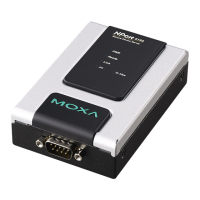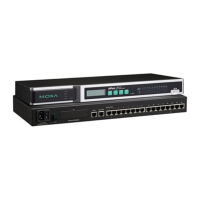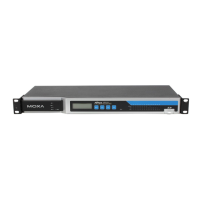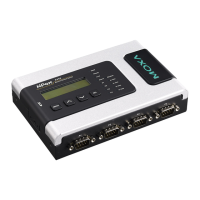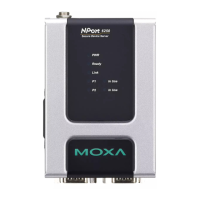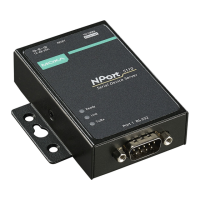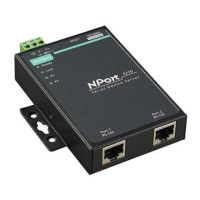NPort 6000 Series Configuration with the Web Console
IPv6 DNS server 2: This is an optional field. The IP address of another DNS server may be entered in this field
for when DNS server 1 is unavailable.
Connection Priority: This function should work with the NPort 6000 functions that use the domain name to
obtain the IP address of the remote host/server. For this kind of application, the NPort 6000 will ask for the IP
address of the remote host/server through the DNS, and the DNS will reply with both the IPv4 and IPv6 IP
addresses if both exist simultaneously in the remote host/server. For this reason, you need to define which one
has higher priority, IPv6 first (RFC 3484) or IPv4 first.
Applications that obtain the IP address from the domain name:
Application Time Server, DDNS, WINS, RADIUS Server, TACACS+ Server, Remote Syslog, E-
SNMP Tarp Alert.
OP Mode TCP Client, Reverse RealCOM, Pair connection, Terminal
LAN1 speed (default=Auto): You may configure the network speed for the built-in Ethernet connection on
the NPort 6000. IEEE 802.3 Ethernet supports auto negotiation of transfer speed. However, some
switches/hubs require that the communication speed be fixed at 100 Mbps or 10 Mbps. Note that there is no
option for configuring the network speed for the optional network modules for the NPort 6600 and 6450.
Advanced Network Settings
You can access Advanced Network Settings by expanding the Network Settings item in the navigation panel.
Advanced Network Settings is where the routing protocol and gratuitous ARP are configured.
What is RIP?
RIP (Routing Information Protocol) is a protocol used to manage routing information within a self-contained
network, such as a corporate LAN (Local Area Network) or an interconnected group of such LANs.
By using RIP, a gateway host with a router can send its entire routing table, which lists all the other hosts it
knows about, to its closest host every 30 seconds. The closest host in turn will pass this information on to its
neighbor, and so on, until all the hosts within the network have the same routing path information. This state
is known as network convergence. RIP uses a hop count as a way of determining network distance. (Other
protocols use more sophisticated algorithms that also include timing.) After receiving a packet headed for a
specific destination, a network host with a router uses the routing table information to determine the next host
to route the packet to.
RIP is considered an effective solution for small homogeneous networks. For larger, more complicated
networks, transmitting the entire routing table every 30 seconds can bog down the network with a lot of extra
traffic.
RIP 2 is an extension of RIP. Its purpose is to expand the amount of useful information contained in RIP packets
and to add security elements. RIP 2 has become the standard version of RIP, and the original RIP is no longer
used.
Routing Protocol: You may select which routing protocol, if any, your network will employ.
Gratuitous ARP: In some applications, you may need the NPort 6000 to send broadcast packets to update the
ARP table on the server. If you enable this function and set the send period, the NPort 6000 will send
periodically send broadcast packets at the specified time interval.
